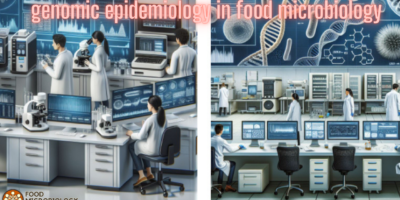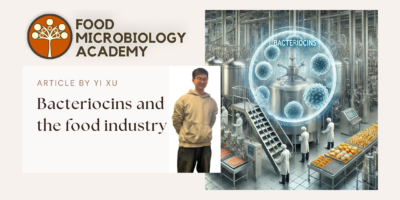This blog article is an extract (very slightly modified/revised) from a student literature review conducted in 2008 by Jiahui Tan, a 3rd-year student of mine at RMIT University in Melbourne.
Egg products (liquid whole egg)
In the US, the most marketed typology is the pasteurized liquid egg product (81.4% of the total production), followed by frozen (13.3%) and dried (5.3%) product. In addition, the liquid whole egg (LWE) (Figure 1) is the most commonly processed product at 64% compared to the individual white and yolk. (Hidalgo et. al., 2008) Hence, the LWE has drawn special attention to the food technologist fundamentally due to its demand and the consumer appreciation for its high protein content of 12.8 – 13.4%. (Li-Chan et. al., 1995). The low cost of LWE being used in prepared meals in order to provide texture, flavour and structure indicates that it has been an important ingredient. (Punidadas & McKellar, 1999) However, the functional properties and sensory attributes of LWE are affected by pasteurization, which is the fundamental process to eliminate pathogenic microorganism.

Standard Processing Method (Pasteurisation)
The most common preservation method for the general egg products is the thermal treatment, having the principle of inactivation of microorganisms by application of heat for a certain time. Pasteurisation of egg products have become mandatory in Australia and the Food Standard Australia New Zealand (FSANZ) require that LWE be heated to a temperature not lower than 64°C for at least 2.5 minutes and immediately rapidly cooled to a temperature not greater than 7°C. (FSANZ, 2008a) This data are similar to Food Standards Agency (FSA),. a regulation used in United Kingdom (UK). However, it was claim by the British researchers that the current regulations approved by Food and Drug Administration (FDA) in the United States (US) of using 60oC for at least 3.5 minutes is insufficient treatment to ensure a satisfactory product in the UK. (Cunningham, 1995) This time-temperature combination for US regulations was mentioned to have an important advantage of determining the adequacy of pasteurization by using an enzymatic test, but it does not work for time-temperature as recommended in Australian and British regulations. (Cunningham, 1995)
Advantage of Pasteurisation
Pasteurisation represents the best understood technology and is identified as the most effective method for elimination of pathogens in eggs products. (Calderon-Miranda et. al., 1999; Unluturk et. al., 2008) According to FSANZ, FSA and FDA regulations, the LWE must not be sold or used in the manufacture of food unless it has been pasteurized and cooled within the conditions stated above. In a study by Manas et. al. (2003), the time-temperature combinations used in the three countries should be able to provide a 5-9 log cycle reduction in the number of Salmonella (Figure 2). This indicates the importance of a treatment to reduce the Salmonella load as only egg products that are Salmonella- negative can be sold.

Hidalgo (2008) suggests that a pasteurized egg product can reach a shelf-life of 28 days with more severe heat treatments using aseptic packaging. It is crucial that a starting material has good hygiene quality and is adequately handled during breaking. Ultimately, an extension in shelf life of an egg product is determined by its ability to stay contamination-free throughout its processing.
Disadvantage of Pasteurization
Although pasteurisation is the most available technique and literature has little evidence in causing any significant change in egg nutrition value, it may affect the functional properties of the LWE such as the foaming, coagulation and emulsifying properties. (Gongora-Nieto et. al., 2003; Hermawan et. al., 2004) Examples of a classic test by Cunningham (2005), are beating rate, meringue stability and angel cake-volume. As for the coagulation ability, it can be reflected by the stiffness of custard and the indication of the emulsifying power of whole egg can be evaluated by the stability of mayonnaise.
Ponce et. al., (1998), reported that egg proteins are susceptible to coagulation or thermal denaturation with the formation or destruction of covalent bonds (Figure 3). Hence, pasteurisation may affect the sensorial quality of LWE, leading to a less desirable product. With the alteration to the colour, texture and impairing of functional properties, it loses the important value of LWE to consumers.
Susceptibility to MicroorganismAlthough the contents of freshly laid eggs are sterile, the shell surface contains many bacteria. Higalgo (2008) reported that it is very important to avoid any contact between the internal egg content with the dirty shell surfaces which can reach to 107-108cfu/g. The LWE may be contaminated during processing and supports growth of pathogens such as Campylobacter (Neil et. al, 1985; Evans et. al., 2003), Listeria monocytogenes (Brackett & Beuchat, 1991; Dobbenie et. al., 1995), Salmonella (Manas et al., 2003; Messens et. al., 2005), Yersinia enterocolitica (Hanna, et. al., 1977; Favier et. al., 2005). The contamination and growth of bacteria in egg products can alter the sensory aspects and is potentially dangerous for consumption as it could compromise the consumer safety.
References
Brackett, R. E., & Beuchat, L. R. (1991). Survival of Listeria monocytogenes in whole egg and egg yolk powders and in liquid whole eggs. Food Microbiology, 8(4), 331-337.
Calderon-Miranda, M. L., Barbosa-Canovas, G. V., & Swanson, B. G. (1999). Inactivation of Listeria innocua in liquid whole egg by pulsed electric fields and nisin International Journal of Food Microbiology, 51, 7-17
Cunningham, F. E. (1995). Egg-Product Pasteurisation In W. J. Stadelman & O. J. Cotterill (Eds.), Egg Science & Technology (4th ed., pp. 289-316): New York: Food Products Press.
Dobbenie, D., Uyttendaele, M., & Debevere, J. (1995). Antibacterial Activity of the Glucose-oxidase Glucose System in Liquid Whole Egg. [Article]. Journal of Food Protection, 58(3), 273-279.
Evans, M. R., Ribeiro, C. D., & Salmon, R. L. (2003). Hazards of healthy living: bottled water and salad vegetables as risk factors for Campylobacter infection. 1225. Emerging Infectious Diseases, 9(10), 1219-1225.
Favier, G. I., Escudero, M. E., & Guzman, A. M. S. (2005). Gentotypic and phenotypic characteristics of Yersinia enterocolitica isolated from the surface of chicken eggshells obtained in Argentina. Journal of Food Protection, 68, 1812-1815.
Food Standards Australia New Zealand (FSANZ). (2008a). Standard 1.6.2: Processing Requirements. Retrieved August 17, 2008, from: http://www.foodstandards.gov.au/_srcfiles/Standard_1_6_2_Processing_v951.doc
Góngora-Nieto, M. M., Pedrow, P. D., Swanson, B. G., & Barbosa-Cánovas, G. V. (2003). Energy analysis of liquid whole egg pasteurized by pulsed electric fields. Journal of Food Engineering, 57(3), 209-216.
Hanna, M. O., Stewart, J. C., Zink, D. L., Carpenter, Z. L., & Vanderzant, C. (1977). Development of Yersinia enterocolitica on raw and cooked beef and pork at different temperatures Journal of Food Science, 42, 1180-1184.
Hermawan, N., Evrendilek, G. A., Dantzer, W. R., Zhang, Q. H., & Richter, E. R. (2004). Pulsed electric field treatment of liquid whole egg inoculated with Salmonella enteritidis. Journal of Food Safety, 24(1), 71-85.
Hidalgo, A., Franzetti, L., Rossi, M., & Pompei, C. (2008). Chemical markers for the evaluation of raw material hygienic quality in egg products. Journal of Agricultural and Food Chemistry, 56(4), 1289-1297.
Li-Chan, E. C. Y., Powrie, W. D., & Nakai, S. (1995). The Chemistry of Eggs and Egg Products. In W. J. Stadelman & J. C. Owen (Eds.), Egg Science & Technology (4th ed., pp. 105-151): New York: Food Product Press.
Manas, P., Pagan, R., Alvarez, L., & Uson, S. C. (2003). Survival of Salmonella senftenberg 775W to current liquid whole egg pasteurization treatments. Food Microbiology, 20, 593-600.
Messens, W., Grijspeerdt, K., & Herman, L. (2005). Eggshell penetration by Salmonella: a review. [Review]. Worlds Poultry Science Journal, 61(1), 71-85.
Neill, S. D., Campbell, J. N., & Obrien, J. J. (1985). Egg Penetration by Campylobacter jejuni. Avian Pathology, 14(3), 313
Ponce, E., Pla, R., Mor-Mur, M., Gervilla, R., & Guamis, B. (1998). Inactivation of Listeria innocua inoculated in liquid whole egg by high hydrostatic pressure. [Article]. Journal of Food Protection, 61(1), 119-122.
Punidadas, P., & McKellar, R. C. (1999). Selected physical properties of liquid egg products at pasteurization temperatures. Journal of Food Processing and Preservation, 23, 153-168.
Unluturk, S., Atilgan, M. R., Baysal, A. H., & Tari, C. (2008). Use of UV-C radiation as a non-thermal process for liquid egg products (LEP). Journal of Food Engineering, 85(4), 561-568..




Leave a Reply